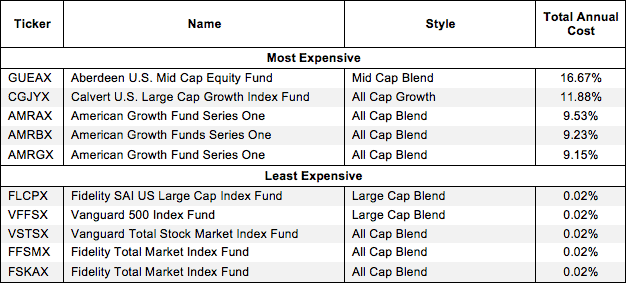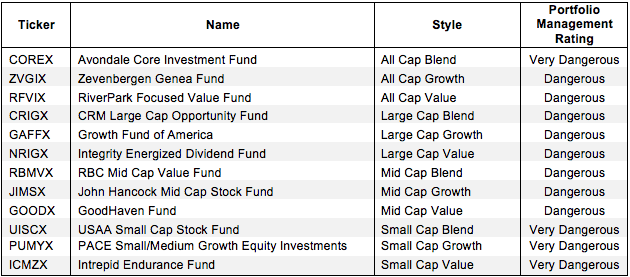Question: Why are there so many mutual funds?
Answer: Mutual fund providers tend to make lots of money on each fund so they create more products to sell.
The large number of mutual funds has little to do with serving investors’ best interests. Below are three red flags investors can use to avoid the worst mutual funds:
- Inadequate Liquidity
This issue is the easiest issue to avoid, and our advice is simple. Avoid all mutual funds with less than $100 million in assets. Low levels of liquidity can lead to a discrepancy between the price of the mutual fund and the underlying value of the securities it holds. Plus, low asset levels tend to mean lower volume in the mutual fund and larger bid-ask spreads.
- High Fees
Mutual funds should be cheap, but not all of them are. The first step here is to know what is cheap and expensive.
To ensure you are paying at or below average fees, invest only in mutual funds with total annual costs below 1.85%, which is the average total annual cost of the 5,952 U.S. equity Style mutual funds we cover. The weighted average is lower at 1.17%, which highlights how investors tend to put their money in mutual funds with low fees.
Figure 1 shows Aberdeen US Mid Cap Equity Fund (GUEAX) is the most expensive style mutual fund and Fidelity SAI US Large Cap Index Fund (FLCPX) is the least expensive. American Growth (AMRAX, AMRBX, AMRGX) provides three of the most expensive mutual funds while Fidelity (FLCPX, FFSMX, FSKAX) mutual funds are among the cheapest.
Figure 1: 5 Least and Most Expensive Style Mutual Funds
Sources: New Constructs, LLC and company filings
Investors need not pay high fees for quality holdings. Fidelity SAI U.S. Large Cap Index Fund (FLCPX) earns our Very Attractive rating and has low total annual costs of only 0.02%.
On the other hand, TIAA-CREF Small Cap Blend (TISBX) holds poor stocks and earns our Very Dangerous rating, yet has low total annual costs of 0.18%. No matter how cheap a mutual fund, if it holds bad stocks, its performance will be bad. The quality of a mutual fund’s holdings matters more than its price.
- Poor Holdings
Avoiding poor holdings is by far the hardest part of avoiding bad mutual funds, but it is also the most important because a mutual fund’s performance is determined more by its holdings than its costs. Figure 2 shows the mutual funds within each style with the worst holdings or portfolio management ratings.
Figure 2: Style Mutual Funds with the Worst Holdings
Sources: New Constructs, LLC and company filings
No one provider appears more often than any other in Figure 2.
RiverPark Focused Value Fund (RFVIX) is the worst rated mutual fund in Figure 2. GoodHaven Fund (GOODX), Avondale Core Investment Fund (COREX), John Hancock Mid Cap Stock Fund (JIMSX), Intrepid Endurance Fund (ICMZX), PACE Small/Medium Growth Equity Investments (PUMYX), USAA Small Cap Stock Fund (UISCX), Integrity Energized Dividend Fund (NRIGX), Zevenbergen Genea Fund (ZVGIX), and RBC Mid Cap Value Fund (RBMVX) also earn a Very Dangerous predictive overall rating, which means not only do they hold poor stocks, they also charge high total annual costs.
Our overall ratings on mutual funds are based primarily on our stock ratings of their holdings.
The Danger Within
Buying a mutual fund without analyzing its holdings is like buying a stock without analyzing its business and finances. Put another way, research on mutual fund holdings is necessary due diligence because a mutual fund’s performance is only as good as its holdings’ performance. Don’t just take our word for it, see what Barron’s says on this matter.
PERFORMANCE OF MUTUAL FUND’s HOLDINGs = PERFORMANCE OF MUTUAL FUND
This article originally published here on February 9, 2017.
Disclosure: David Trainer, Kyle Guske II, and Kyle Martone receive no compensation to write about any specific stock, style, or theme.
Scottrade clients get a Free Gold Membership ($588/yr value) as well as 50% discounts and up to 20 free trades ($140 value) for signing up to Platinum, Pro, or Unlimited memberships. Login or open your Scottrade account & find us under Quotes & Research/Investor Tools.

